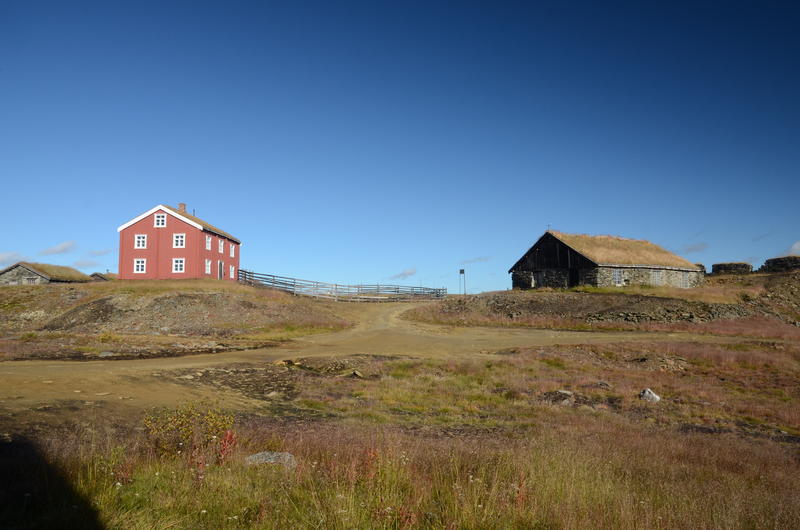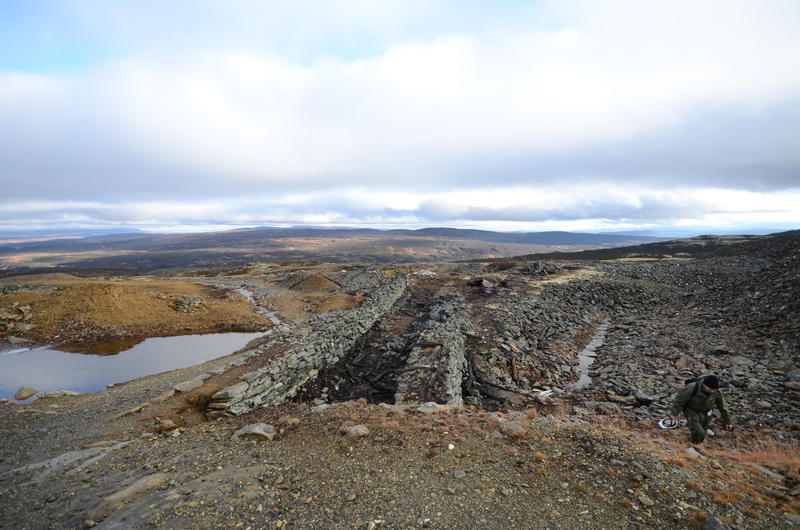Magnar Johnsen and Tone Rygg
Copper, zinc, chrome and pyrites were extracted, but copper was the dominant export commodity throughout the Company?s history. Total production from 1644 until 1977 is about 110,000 tons of pure copper.
The most productive mines were situated in the area around Storwartz and Nordgruvene. Funngruva (The discovery mine) Gamle Storwartz was started up after Hans Aasen discovered traces of copper during a reindeer hunt. During the 1600s several more mines were opened up in the Storwartz area. Work in the Nordgruva started in Arvedals mine in 1657 and there were several more mines worked in this area during the 1700s. At Nordgruvene during the second half of the 1800s pyrites was the main type of ore extracted, but at Storwartz copper pyrite was always the main product. In addition to the two main districts of mining there have been many claims throughout the circumference area in the search for minerals and many mines have been worked in the Røros region.
Digging out and breaking rock can be considered the ?impossible art?. During the 1600s and 1700s much of the work was done by hand tools and human labour. The ore was broken out of the rock by the lighting of enormous wood fires to heat up the rock and force it to expand and become brittle and crack. This makes it relatively easy to use crowbars and hack the ore out of the rock face. The method of firing up was the most usual way of getting the ore out of the rock and was the method used in the mines for the first 100 years of production. However, the lack of wood led to the use of explosives as early as the 1600s. Holes were drilled by hand, using sledge-hammers, chisels and long crowbars. The holes were then filled with gunpowder sealed off with clay or with wooden plugs and then the fuse was touched off. This method made the work easier but the difficulties of the drilling of blasting holes by hand made the work labour intensive. (B.I. Berg, Fjell-Folk, 1988). By the end of the 1800s many improvements were introduced such as, electricity and dynamite. Compressed air power tools and dynamite was used to break out or blast out the rock faces. Electrically operated compressors were place down in the mines to supply the compressed air for the drills.
Ventilation, the pumping out of water and the transportation of the ore were some of the challenges in the business of mining. Carbon and sulphur gases from the firing up process had to be forced out of the mines as quickly as possible, and the shafts (i.e. vertical pits holes leading up to the surface and down into the mine) ensured some circulation of air. The shafts were also used for lifting out the ore or pumping water. The entrance of water was a constant problem in many of the mines and the pumping out of water was essential in order to be able to work. Technical development has also made great strides in this area, from hand carrying water out of the mine, to horse driven bucketing, or the use of water wheels to supply power to pumps and finally electrically powered pumps. The methods of transportation of ore out of the mines have also been the subject of great improvement in the industry?s history. In the early days of mining leather sacks were used, and then, trestles carried between two men, carried in wheelbarrows from the rock face to a place where horses dragged it out in carts or it was lifted up through vertical shafts. Later, a system known as ?slepheis? (literally: pull-lift) was used where horses on the surface pulled the ore out of the mine. And then electricity arrived and the mine was equipped with an electric railway and electric winches. The first electric locomotive was taken into use at Kongens Gruve in 1896.
The first rough sorting of the ore was done near the mines themselves. In the beginning this was carried out by hand shovelling and the use of hand-held sledge-hammers. Towards the end of the 1700s water ? powered piston crushers were introduced, these were enormous logs of wood with cast- iron tips pounding the ore. Final sorting of the copper ore was done closer to the smelter. Much of this work was done by young boys, who were given the nickname, ?vaskarryssen?.(lit: the washer lads). The copper ore was then transported closer to the smelting houses. In 1920 a floatation separator was introduced at Storwartz where the ore was reduced to a concentrate prior to smelting.
In the old days, the miners worked a ten-hour day, for five days a week. This was probably the norm right from the beginning. In the early days flexibility in working time was allowed, the miners were allowed to leave work whenever it suited them, provided they worked back the hours they had taken free. This arrangement was stopped in 1713. From the early 1700s the miners eventually had to live at the mines in barracks for the whole week from Monday until Friday. They ate and slept in these large barracks, which had with sleeping ledges built along the walls and open fireplaces in the middle of the floor. In the early days all permanently employed workers were paid ?schikt-lonn? a daily wage, which was paid out monthly. From about 1720 piecework was introduced for certain types of labour. Other types of work were auctioned off to gangs who accepted the lowest rates. Contract and piece rates became the usual system of payment by the 1800s in order to reduce labour costs and improve the efficiency in the mines.
Literature
Dahle, H.: Røros Kobberverk 1644-1894. Kristiania 1894
Ødegaard, Sverre: ?Bergbryting i eldre tid.? Særtrykk av Fjell-Folk, 1982.
Berg, Bjørn Ivar: ?Kaldkiling, fyrsetting og kruttsprengning. To stadier i bergbrytingens historie.? Fjell-Folk, 1988

